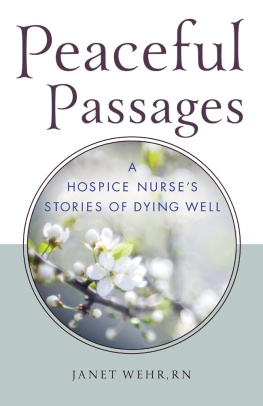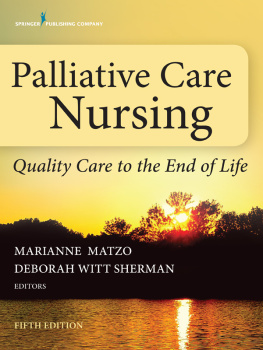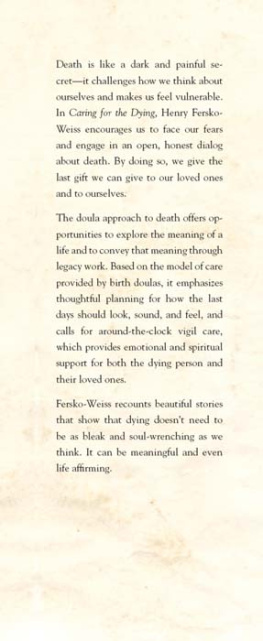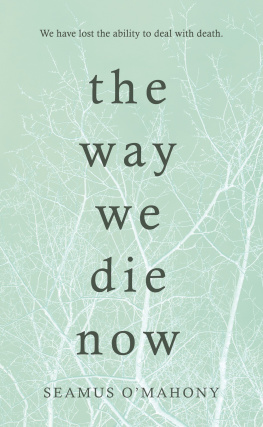Deborah Sherman - Final Moments: Nurses Stories about Death and Dying (Kaplan Voices)
Here you can read online Deborah Sherman - Final Moments: Nurses Stories about Death and Dying (Kaplan Voices) full text of the book (entire story) in english for free. Download pdf and epub, get meaning, cover and reviews about this ebook. year: 2009, publisher: Kaplan Publishing, genre: Science fiction. Description of the work, (preface) as well as reviews are available. Best literature library LitArk.com created for fans of good reading and offers a wide selection of genres:
Romance novel
Science fiction
Adventure
Detective
Science
History
Home and family
Prose
Art
Politics
Computer
Non-fiction
Religion
Business
Children
Humor
Choose a favorite category and find really read worthwhile books. Enjoy immersion in the world of imagination, feel the emotions of the characters or learn something new for yourself, make an fascinating discovery.
- Book:Final Moments: Nurses Stories about Death and Dying (Kaplan Voices)
- Author:
- Publisher:Kaplan Publishing
- Genre:
- Year:2009
- Rating:3 / 5
- Favourites:Add to favourites
- Your mark:
- 60
- 1
- 2
- 3
- 4
- 5
Final Moments: Nurses Stories about Death and Dying (Kaplan Voices): summary, description and annotation
We offer to read an annotation, description, summary or preface (depends on what the author of the book "Final Moments: Nurses Stories about Death and Dying (Kaplan Voices)" wrote himself). If you haven't found the necessary information about the book — write in the comments, we will try to find it.
Deborah Sherman: author's other books
Who wrote Final Moments: Nurses Stories about Death and Dying (Kaplan Voices)? Find out the surname, the name of the author of the book and a list of all author's works by series.
Final Moments: Nurses Stories about Death and Dying (Kaplan Voices) — read online for free the complete book (whole text) full work
Below is the text of the book, divided by pages. System saving the place of the last page read, allows you to conveniently read the book "Final Moments: Nurses Stories about Death and Dying (Kaplan Voices)" online for free, without having to search again every time where you left off. Put a bookmark, and you can go to the page where you finished reading at any time.
Font size:
Interval:
Bookmark:
final
moments
Nurses Stories
about Death
and Dying
Deborah Witt Sherman, PhD, APRN, ANP, BC, ACHPN, FAAN
Editor

Contents
I N Final Moments , nurses reveal glimpses behind the curtain, as they bear witness to the final days of their patients lives, learn to appreciate the sanctity of life, and discover how to face death with dignity. Nurses understand that dying and death may be an opportunity for growth, self-actualization, and healing.
Final Moments is a collection of powerful stories that reveals the lived experiences of nurses from all over the country, in various clinical settings as they care for seriously ill and dying patients. The stories are snapshots that capture the intense emotional and spiritual connection of nurses, patients, and families.
For many, the desire to become a nurse began in early childhood when she or he witnessed the death of a beloved family member. From that point forward, having coped with their own loss and grief, they were called to accompany individuals through the illness experience, with a need to celebrate life while preparing for death. In the story entitled Never Too Late, Rachel Shinabarger tells us about the experiences of student nurses and how they are expected to provide physical, emotional, and spiritual care to dying patients, yet are unprepared educationally or emotionally for the experience. Other nurses seek experiences in the care of the dying as their hearts rejoice when they can alleviate suffering and provide true presence to patients and families.
Nurses own personal issues of loss and grief create the emotional space to understand the needs, fears, hopes, and dreams of patients and families as they face death. In the story, There Are No Coincidences, Patrice Piretti describes how nurses identify with patients close to their own age or who share a common heritage. She explains how nurses memories of beloved family members are often awakened by patients who shared similar characteristics and represent the spirit of their heritage. In the story, Changing Seasons, Terry Ratner describes the need for connection with a patient: the relationship soothed her broken heart. In this story, we learn that nurses may perceive death as either coming too soon, or as freedom from pain.
In the story entitled She Inspired Me, we understand that nurses are angels but that patients are angels, too. The relationship between a nurse and patient is reciprocal as both hearts are joined in faith and hope to create opportunities for healing.
Openness and trust endear patients and nurses to one another. When nurses encourage patients and families to tell their own life story, nurses demonstrate their respect for the patients unique life and provide validation for their life experience. Mary DeLisle-Berry, in the story Hes Coming, describes how nurses gain insight into family dynamics and long standing family conflicts. With such knowledge, nurses can facilitate communication, which may move families to resolve disagreements or at least call a truce for the good of the dying person. As role models, many nurses reveal ways of supporting families at a time when they need to also support each other.
In the story entitled House Call, Cortney Davis tells us how families rely on the clinical judgment of nurses and await their assessments anticipating the unimaginable and are gently prepared by nurses as to what to expect. Patients and families ask nurses, What would you do in this situation? As revealed in these stories, nurses individualize their approach to care, helping patients and families to understand their own choices based on their personal wishes and preferences, while recognizing the burden and benefits related to each treatment decision. Nurses realize that the voices of patients must be heard, and at times nurses become the voices of patients as they advocate for their best interest within the health care system.
Many of the stories, including Mels Story, written by Pato Cog, tell us that nurses are receivers as well as givers in the care of dying patients and families. Nurses learn from patients how to die with dignity maintaining a positive attitude despite physical and emotional suffering and how life and its joys should never be taken for granted. Patients teach nurses about living in the moment and the importance of not burying them, until they are dead. Many of the nurses in these stories understand that people can actualize their potential even as death approaches leaving a legacy for families and imprinting the hearts of nurses.
Several of the stories show us how nurses suffer when their patients suffer never forgetting what they have witnessed. This is found in Wicked Codes by Karen Klein and in Emily McGees An End to the Madness, as nurses witness painful procedures that are attempted over and over again.
Yet, nurses find their voices in protection of their patients, advocating for an end to painful treatments, while offering comfort and reassurance when the procedure is requested by the patient or deemed necessary by the medical staff. As described in the story entitled Pearls, Sarah Burns reveals that nurses often wish that they had their own magic wand to alleviate pain caused by the disease itself or its treatment. The magic wand of nurses becomes a wand that offers hope, not for cure, but for connection, and opportunities for healing on emotional, social, and spiritual levels.
In bearing witness to suffering, nurses often struggle with their own post-traumatic stress. Davis, who also wrote the First Night reveals the fear and anxieties of nurses who are frightened by their own inexperience in caring for seriously ill patients, often questioning their own abilities and fearing that they have contributed to the patients death. They ask, What could I have done differently or How could I have saved him? This line of questioning is evident when an expert nurse, as described by Adrienne Zurub in the story Tender Mercy badgers herself and laments that she was unable to save her own mother. As readers, we come to understand that personal and professional experiences of loss and grief are closely connected. We learn that death experiences not only can overwhelm novice or student nurses, but those with years of experience. In Zurubs story, we also learn how other health professionals may be unaware of anothers emotional pain and that it is the rituals of the operating room which create a mask for grief following the death of the authors mother.
Anne Webster, in her story The First Patient, tells us that death may be viewed as a failure of nurses abilities to protect the patient and in such situations the nurse reveals feelings of remorse and guilt at being unable to do more to save a patient. We learn of the nurses desire for greater knowledge, and the further development of their clinical skills. But Webster explains that nurses need to learn that death is not a failure, but that nurses simply do the best they can for patients and that life and death are not always in their control. In her story God Bless the Child, Cara Muhlhahn reminds us, once again, that death may be unavoidable no matter how skilled are the nurses and other members of the health care team, nor the availability of medical technology. Babies and children do die and that death may be unexpected. In telling her story about Carol, Geraldine Gorman recognizes that people die in the prime of their lives and that life must be celebrated every day. A critically important message is expressed in a story written by Linda L. Lindeke, called Susies Story as the author reminds us that the nurses role is to listen, offer support, serve as an advocate and help patients negotiate the health care system.
The most important role of the nurse is to Just Be There be present to the patient and to their family in their most difficult hours. Yet, care of the dying patient is not without its pain for the nurse. In Caring for Mr. B, Nkiru Onyenwe Okammor tells us that nurses may feel confident caring for dying patients, but have difficulty in caring for a deceased person and thereby need the support of their nurse colleagues. Keith Carlson in his story A Nurses Recovery from Grief explains how nurses bring to their practice their own personal experiences of loss and grief and that grieving is a process with physical, emotional, psychological, and spiritual manifestations. He suggests that the tool kit to cope with grief includes writing/journaling, psychotherapy, mindfulness mediation, exercise, and short-circuiting negative thoughts that bring distress. This story emphasizes that nurses must continue to care for themselves in ways that honor their grief and trust their inner sense of right action.
Next pageFont size:
Interval:
Bookmark:
Similar books «Final Moments: Nurses Stories about Death and Dying (Kaplan Voices)»
Look at similar books to Final Moments: Nurses Stories about Death and Dying (Kaplan Voices). We have selected literature similar in name and meaning in the hope of providing readers with more options to find new, interesting, not yet read works.
Discussion, reviews of the book Final Moments: Nurses Stories about Death and Dying (Kaplan Voices) and just readers' own opinions. Leave your comments, write what you think about the work, its meaning or the main characters. Specify what exactly you liked and what you didn't like, and why you think so.










